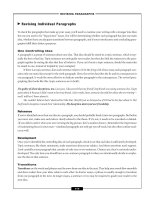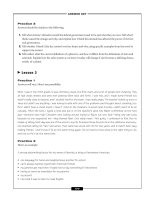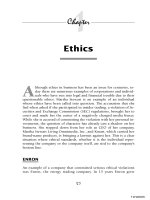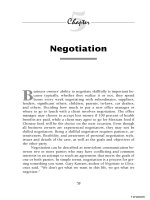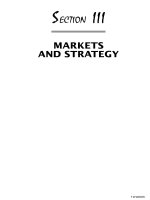MBA In A Day Chapter 13 pptx
Bạn đang xem bản rút gọn của tài liệu. Xem và tải ngay bản đầy đủ của tài liệu tại đây (680.66 KB, 17 trang )
13
E-Commerce and Uses
of the World Wide Web
T
he Internet is the starting point for an exploration of e-com-
merce, and the World Wide Web is a worldwide collection of
computer networks, cooperating with each other to exchange
data using a common software standard. Though considered by many
as a new technology, the Internet has been around for several decades.
Originally known as ARPAnet, the Internet was created in 1969 by the
U.S. Department of Defense as a nationwide computer network that
would continue to operate even if the majority of it were destroyed in a
nuclear war or natural disaster. It was not until 1992 that commercial
entities started offering Internet access to the general public, and the
business world has not been the same since.
THE EFFECT OF THE INTERNET ON BUSINESSES
Over the past decade, widespread Internet and e-mail access have radi-
cally changed the way companies do business and communicate with
their employees, vendors, and customers. Consumers and businesses
purchase products and services such as $2,000 laptops and airline tick-
ets by paying with credit cards via the Internet without ever speaking
Chapter
247
ccc_stralser_ch13_247-263.qxd 7/22/04 9:08 AM Page 247
TLFeBOOK
to a customer representative or salesperson. Many companies allow
customers to track the status of their orders online to see when their
products shipped and when they are scheduled to arrive, again without
ever speaking to a customer representative. When companies such as
Amazon and Priceline emerged, their business models revolved around
conducting 100 percent of their business online, eliminating the need
for costly bricks-and-mortar outlets. More and more consumers are
paying their bills online as they become comfortable with online secu-
rity, thus eliminating the need to pay postage and write checks for each
bill using the traditional snail-mail method. Today thousands of adults
are getting their undergraduate and master’s degrees online without
ever attending an actual class or meeting their peers or professors, who
teach the classes online. There are few businesses or organizations iso-
lated from this transformational wave of technology and innovation.
INTERNET FACTS
According to www.internetworldstats.com, the total number of Inter-
net users worldwide as of February 2004 is 719.3 million. This is ap-
proximately 11.1 percent of the total world population of 6.45 billion.
IDC Research predicts that this number will exceed one billion users
by the end of 2005. The United States is still the country with the
highest number of Internet users at 186.5 million, 63.3 percent of the
total population of the country, which stands at 295.5 million. Asia
ranks highest as the continent with the most number of Internet users
with a total of 229.82 million. North America is second at 203.38 mil-
lion versus 203.28 million for Europe. Additionally, the countries
with the highest percentage of the population using the Internet in-
clude Sweden (76.9 percent), Netherlands (66.0 percent), and Aus-
tralia (64.2 percent).
DESCRIPTION OF TYPICAL INTERNET USERS
According to the UCLA World Internet Project’s findings based on re-
search collected from 2002 to 2003, in general, around the world men
are more likely (in some countries, such as Italy and Spain, much more
SYSTEMS AND PROCESSES
248
ccc_stralser_ch13_247-263.qxd 7/22/04 9:08 AM Page 248
TLFeBOOK
likely) to use the Internet than women. However, in countries such as
the United States, Sweden, and Taiwan, the ratio of men to women
who use the Internet is nearly 1:1.
It is interesting to note that according to the study, the average In-
ternet user watches less television than non-Internet user counter-
parts. For example, in the United States, Internet users watch 5.2
hours less television per week. Internet users are also more likely to
spend time reading books and engaging in social activities. They also
tend to be more educated and have higher total household incomes.
DEFINITION OF WEB-BASED
SYSTEMS AND E-COMMERCE
A Web-based system is a business process that is supported and ac-
cessed online. For example, e-commerce, a Web-based system involv-
ing purchasing products online, may include features such as charge
card approval systems and customer order tracking systems, which
provide companies with the opportunity to sell their products and ser-
vices online more efficiently. Many internal employee Web-based sys-
tems such as payroll, vendor selection and ordering, time sheet, and
expense report submissions are also examples of Web-based systems.
As an example of how Web-based systems are changing the way
organizations harness the power of the Web, let’s look at the payroll
function. Companies have to provide their employees with benefit in-
formation, taxes paid, vacation/sick days remaining, and so on each
time they get paid. To complicate matters even further, of the people
on payroll, some are contractors and part-time workers, while others
are considered regular employees. If the company’s payroll system is
Internet-based, data can be entered by disparate reporting units, in a
wide array of geographic locations, away from the headquarters’ ac-
counting and payroll office, if needed. The online system is able to
keep better track of the number of vacation days, amount of 401(k)
contributions, and health insurance deductions on each employee’s
pay stub.
The process of accounting for employees’ time can also be auto-
mated, eliminating the need for manually totaling payroll hours and
time cards, reducing the number of errors, and providing immediate
E-Commerce and Uses of the World Wide Web
249
ccc_stralser_ch13_247-263.qxd 7/22/04 9:08 AM Page 249
TLFeBOOK
real-time data for managers, allowing them to make more department-
specific, accurate, time-sensitive decisions. A Web-based payroll sys-
tem is beneficial not only to human resources staff, but also to
employees. They no longer have to make copies of their time sheets
when they turn in the originals because past time-sheet records are
available on the Internet for viewing and printing, and they no longer
have to worry about calculational errors while adding numbers be-
cause the time sheets are automatically calculated online. The system
also enables employees to fill out their time sheets while they are away
from the office, which is especially convenient for those who spend a
significant amount of time in the field.
Clients also appreciate suppliers and service providers who use
Web-based systems. Not only does providing clients with access to in-
formation on your web site save them time, it saves you time as well.
Allowing clients to access old reports and data from previous and cur-
rent projects by using a password online saves you from having to
take time out of your busy day to print out the report and ship it to
the client. The client is able to log in online and make copies of the re-
port himself, and the benefit to him is that he can access the informa-
tion immediately. He does not have to wait for you to return from out
of town to print his file and then wait another day or two to receive it
in the mail. Clients can also access project and budget updates, partic-
ipate in virtual conferences and meetings, and retrieve invoices on-
line. While clients find the online process to be convenient and quick,
your company saves time and money and also benefits from the
“stickiness” factor. Once a client gets used to accessing information
using your system, she will be less likely to switch her business to one
of your competitors. As discussed in Chapter 8, this notion of switch-
ing costs is a key driver of customer loyalty and competitive advan-
tage. Once clients understand and build trust in your system, they
will be less likely to risk working with a company that does not offer
this service to its clients or spend the time to learn how to use another
company’s system.
An example of a company that takes advantage of the stickiness
factor is Bank of America. The company used to charge customers for
online banking, but now it offers the service for free. The bank realized
that once customers spend time inputting all the information required
SYSTEMS AND PROCESSES
250
ccc_stralser_ch13_247-263.qxd 7/22/04 9:08 AM Page 250
TLFeBOOK
to use online banking and learning their system, they will be less likely
to move their account to another financial institution.
Another Internet-based system that many companies have imple-
mented is electronic bidding for products and services, meaning that
proposal bids are sent electronically instead of via regular mail or pa-
per-based systems. Benefits to companies of the electronic bidding sys-
tem include the arrival of bids in a consistent, legible format free of
calculation errors, and a reduction in the amount of man-hours and
other resources needed to print, distribute, and edit bids. The suppliers
who are bidding also benefit from the process because they have access
to project bidding information 24 hours a day, and they can send in
their bids even when they are away from their offices. Additionally, the
number of errors made on the forms is reduced because the system de-
tects them and will not accept them unless they are completed in their
entirety and are free of errors. Other advantages of electronic bidding
are the elimination of travel expenses and confirmation of delivery of
bid on the supplier side.
Although they may cost several thousand dollars to set up and
their maintenance and support functions may have to be outsourced,
in general Web-based systems are more cost-efficient since they save
on printing, human labor, mailing, and invoice costs.
As customers grow more comfortable with security issues regard-
ing purchasing products online, Jupiter Research predicts e-com-
merce—purchasing products or services online—will continue to grow
over the next five years, specifically among small businesses that have
established a reputation among consumers for being entities that are
legitimate and trustworthy. In addition, Jupiter Research predicts e-
commerce will grow from $65 billion in 2004 to $116 billion by 2008,
and the percentage of U.S. consumers who purchase products online
will increase from 30 percent in 2004 to 50 percent by 2008.
ADVANTAGES AND
DISADVANTAGES OF E-COMMERCE
While e-commerce is expected to continue growing over the next sev-
eral years and trending toward wide adoption to sell products and ser-
E-Commerce and Uses of the World Wide Web
251
ccc_stralser_ch13_247-263.qxd 7/22/04 9:08 AM Page 251
TLFeBOOK
vices online, there are many challenges that should be considered be-
fore implementing an online selling system for your company.
One major concern among consumers is that of security and pri-
vacy of personal information. Consumers want to be assured that the
personal information they provide on a company’s site will not be sold
to other companies for marketing purposes. Others are wary about
technology that tracks personal information such as web sites visited
and items purchased by customers. A major barrier for consumers who
still do not purchase products online is the fear that a web site is not
secure and that their credit card number or other personal information
will be accessed by hackers.
Another reason many consumers choose not to purchase online is
because of viruses. While in the past viruses were often spread by
opening an infected e-mail, these days simply surfing the Internet is
enough to be vulnerable to getting a virus. System downtime is an-
other problem associated with e-commerce sites. Whether the down-
time is a result of system maintenance, server issues, hackers, or poor
system administration, it can have a negative impact on sales. If cus-
tomers are unable to purchase from your site due to technical prob-
lems, they may become dissatisfied and visit the web site of your
competitor instead.
Although there are several challenges associated with e-commerce,
there are also many advantages to selling products online for companies
and customers. One advantage for companies is cost savings through
lower inventory management, customer service, administration, and
communication costs, order tracking, and integration with the com-
pany’s accounting system. Web orders can be sent directly to the ware-
house, which allows customer service representatives to focus on larger
customer orders, while smaller orders can be handled more efficiently
online. Detailed purchase history reports on each customer allow com-
panies to design customized online purchase deals for customers who
have not purchased from their sites in several months or reminder no-
tices to order specific products for customers who purchase specific
products on a regular basis. Current online inventory reports can aid
in projecting inventory depletion and assist with product restocking
information.
Manufacturers of products have the advantage of being able to
sell directly to customers by bypassing the intermediary if they sell on-
SYSTEMS AND PROCESSES
252
ccc_stralser_ch13_247-263.qxd 7/22/04 9:08 AM Page 252
TLFeBOOK
line and are able to pass along some of the savings to their customers.
Another advantage to companies is that sending e-mails to customers
is an effective low-cost way of sending customized messages about up-
coming products, special online purchase offers, or shipping and order
confirmations. Additionally, specific customer information can be
stored for repeat customers, making it easier to analyze customer
groups. Benefits to consumers include 24-hour shopping, conve-
nience, lower prices, special online promotions, comparative shop-
ping, and proactive feedback from the company regarding stock-outs
or delays in shipping.
E-COMMERCE TRENDS
Mitchell Levy of CEOnetworking has compiled a list of top technol-
ogy-related trends for 2004. Of the top 10 trends on his list, two are re-
lated to e-commerce: the increase of spam and viruses and the
continued growth of e-commerce.
According to The Washington Post, spam or unsolicited commer-
cial e-mail accounts for about 50 percent of all e-mails. With the help
of special software, spammers can generate various combinations of
letters and numbers and place the name of a common Internet service
provider (ISP) such as AOL after each @ to create a list of millions of
e-mail addresses, many of which are actual e-mail accounts. Although
as of 2003, 26 states had antispam laws, many people still continue to
send out spam since they are unlikely to get caught, and it is an inex-
pensive way to reach customers. The fact remains that although only a
handful of people out of a thousand people who receive a spam mes-
sage open it and eventually make a purchase, spammers find it worth
their time to spam because the amount of sales generated is higher
than the cost to distribute spam. This creates a problem for legitimate
companies that are sending out e-mails to current or past customers
who may delete them thinking they are spam. Even though many be-
lieve there should be a ban on spam similar to the ban on unsolicited
faxes that came into effect in 1991, others argue that banning spam vi-
olates spammers’ rights to free speech.
As more and more small businesses go online, e-commerce will
E-Commerce and Uses of the World Wide Web
253
ccc_stralser_ch13_247-263.qxd 7/22/04 9:08 AM Page 253
TLFeBOOK
continue to grow in the coming years. According to e-Marketer, 80
percent of small business were online as of 2003.
E-commerce will continue to grow based on wider acceptance,
reliability and security and that growth will accelerate on a
multiplier to economic recovery. That is to say that e-commerce
as a route to market will gain disproportionately from economic
recovery.
—Jeff Drust, vice president, e-business, Autodesk, Inc.
Online sales will continue to rise. Convenience and familiarity are
at work here. Those who have not bought will and those who have
will buy more.
—Jim Sterne, president, Target Marketing
STEPS IN DEVELOPING
AN E-COMMERCE STRATEGY
Depending on whether your company is currently selling online, the
following section may either help you set up a web site or make your
web site more successful. The first thing you should do before you be-
gin the setup is determine what you expect to achieve by creating a
web site. Without determining the scope of the project, it is impossible
to be fully prepared for all the steps involved in the process. Be sure to
consider the following:
✔ What are your goals and objectives for creating this web site?
✔ Which products or services will be provided?
✔ Who will the target market be?
✔ Should you hire an outside firm to help develop and maintain
the web site or should you handle it internally?
✔ If the system will be handled internally, can you afford to hire
a system administrator, Web copywriters, Web designers, pro-
ject director, and/or software engineer?
✔ How will selling online affect your current relationships with
your vendors, salespeople, and employees?
SYSTEMS AND PROCESSES
254
ccc_stralser_ch13_247-263.qxd 7/22/04 9:08 AM Page 254
TLFeBOOK
✔ Will a Web presence contribute to “channel conflict” or the
concerns by intermediaries that they may be bypassed by cus-
tomers, who will be reaching you directly?
✔ Where will the funding for the web site come from?
✔ How much do you expect the total project will cost?
✔ Can your current purchasing, accounting, and supplier sys-
tems be integrated into the web site’s system?
✔ Do you have the infrastructure and customer response capa-
bilities to support volume from the Web?
Setting Up a Web Site
Once you have determined the scope of your web site project, the
next step is to begin setting it up. First you have to create a domain
name that is unique, yet descriptive. To make sure that you choose a
unique company name, you may want to consider working with a
lawyer or name consultant to avoid the hassle of having to change the
name of your company later after finding out the name you picked al-
ready belongs to another company. After you have picked out a
unique domain name, the next step is to contact a Web hosting ser-
vice to secure and register your new domain name. A Web hosting
service hosts your web site on its server. It also offers many features
that you may select from such as offering a shopping cart on your site.
Although it is possible to host your web site on your own server, this
method is not recommended because of the high costs involved in do-
ing so. The more people who visit your site, the more storage space
you will need and the more money you have to pay; make sure the
plan you pick allows for growth.
Although you may hire an outside firm to develop and maintain
your web site, if you plan to make minor changes such as changing
prices on the site you may want to consider having the necessary tools
in your office to handle these minor changes yourself. For example,
you need to consider how your site interacts with major Web browsers
your customers are likely to use, such as Netscape Communicator and
Microsoft Internet Explorer browsers. Since your customers will use
either one of these browsers to access your web site, you need to test
any changes you make in both formats to make sure the changes will
E-Commerce and Uses of the World Wide Web
255
ccc_stralser_ch13_247-263.qxd 7/22/04 9:08 AM Page 255
TLFeBOOK
not cause problems for customers using either browser. You should
also consider purchasing a file transfer protocol (FTP) program to up-
load any new files to your web site and a text editing software program
such as Notepad that comes with Windows. Other tools you may want
to purchase include HTML editors and tutorials, a digital camera, and
graphics equipment.
Web Site Content
There are many things to keep in mind when developing the content
for your web site. In general, web sites should be easy to use, clear, and
concise, and should contain accurate and updated information. While
you want to make sure your web site is interesting enough to entice
visitors to continue browsing and clicking, you do not want to use
graphics that take so long to appear that visitors become frustrated and
leave your site. Be sure to offer visitors the option of viewing your page
in another format if it takes too long to download, and keep your pages
short so they download faster and eliminate the need to use the scroll
bar. It is important to remember that your web site should be consis-
tent with your company’s established brand, logo, mission, culture,
and philosophy to avoid confusing customers, employees, and suppli-
ers. Make sure your web site is user-friendly and easy to navigate. Also
include a site map, and “contact us,” and FAQ (frequently asked ques-
tions) pages.
Alicia Sequerah, CEO of Womenetwork.com, also suggests using
effective marketing copy on your web site, as the site is a part of an in-
tegrated marketing strategy. Sequerah suggests that companies should
use more “you” phrases rather than “we” phrases to show customers
how they will benefit from purchasing your products. For example, try
using “You get . . .” rather than “We offer . . .” solutions to problems
your target market is experiencing.
Test Your Web Site before Going Live
Once the web site is set up, all pages and features should be tested. Try
to send an e-mail from the “contact us” section; try to purchase some-
thing from your shopping cart using a credit card; make sure that a
confirmation e-mail is sent to your e-mail address and another e-mail
SYSTEMS AND PROCESSES
256
ccc_stralser_ch13_247-263.qxd 7/22/04 9:08 AM Page 256
TLFeBOOK
is promptly sent to your supplier; see how long it takes your home
page to appear completely; try to send in a bid. Just make sure you test
all parts of the web site. Upon successful completion of internal test-
ing, the next step is to conduct focus groups or one-on-one interviews
with current customers, vendors, clients, and prospective customers to
find out what they like and dislike about your site, as well as to ask for
suggestions on how to improve it. Once the system goes live, if it does
not work properly you risk frustrating or alienating customers, em-
ployees, and suppliers; so it is best to test it thoroughly and get feed-
back before going live even though you may have to spend more
money than you initially thought.
Web Site Maintenance and Refreshment
Just because your web site is up and running does not mean that your
work is done. Your web site needs constant refreshment, refinement,
and incremental, continuous improvement. Product prices, availability
and descriptions, phone numbers, employee contact information,
news and press releases, and all other sections of your web site must be
updated on a regular basis. Additionally, to increase the number of
times customers visit your web site, you should give them a reason to
revisit your site. Give them the option to bookmark your web site, au-
tomatically add them to your newsletter, customer discount, and order
reminder lists (also extend them the option to decline this offer), offer
links on your web site to complementary web sites your target market
would find interesting, offer sweepstakes or contests online, and make
changes to the web site based on customer feedback. Every visitor to
your web site is a potential customer. Implement ways to capture, and
keep in touch with, visitors to your web site!
Promoting Your Web Site by
Attracting a Target Market
Your company may have a great web site, but you should not subscribe
to the Field of Dreams approach to web site development (“If you build
it, they will come”). You need to make some adjustments so you can
reach your target audience, and conversely, so your customers will find
you. According to Dr. Ralph Wilson, an e-commerce consultant, there
E-Commerce and Uses of the World Wide Web
257
ccc_stralser_ch13_247-263.qxd 7/22/04 9:08 AM Page 257
TLFeBOOK
are many things a company can do to try to reach its target audience.
One thing he suggests companies do is track the number of visitors
who visit their web sites. Your hosting service should be able to pro-
vide these figures to you each month. Some specific things you can
track include:
✔ Agent log—record of links used by those who visited your site.
✔ Browser—Which browser do your visitors use?
✔ Entry page—Which page of your site do visitors see first?
✔ File—number of times a particular file is accessed.
✔ History—analysis of specific features over several months’
time.
✔ Impressions—number of times a logo is viewed.
✔ Path—page sequence followed by visitor.
✔ Repeat visitors—number of repeat visits from same address.
✔ Sales—by frequency, volume, and sales amount.
✔ Sessions—number of times site has been accessed by the same
user in a specific amount of time.
✔ Time—amount of time visitors spend on each page.
Something else Dr. Wilson recommends is submitting your URL
to search engines such as Yahoo! by clicking on the “Add your URL”
link on their web sites, and submit your site to directories such as
About.com. You will be prompted to write a short description of your
web site, so think about what words people would plug into search en-
gines to search for your products and services before submitting the
description of your web site.
Additionally, you should try to find web sites that complement
your products and services and place reciprocal links or banner ads on
them. Writing articles for another web site’s newsletter is another effec-
tive way to spread the word around about your web site. Try develop-
ing your own newsletter, and e-mail it to those who visit your web site
once a quarter. This helps keep your company on their minds. Provid-
ing readers with the option of e-mailing your newsletter to a friend is
another great way to make people aware of your web site. Lastly, don’t
SYSTEMS AND PROCESSES
258
ccc_stralser_ch13_247-263.qxd 7/22/04 9:08 AM Page 258
TLFeBOOK
forget to add your web site address on all your company’s brochures,
stationery, and so on.
Efficiencies of E-Commerce
Once you take the time to set up e-commerce on your web site, you
can leverage the benefits. When a customer places an order, an e-mail
is sent to his e-mail account, thanking him for placing his order with
your company. Another e-mail is sent to your company’s warehouse, a
supplier’s warehouse located nearby, or a manufacturer—whichever is
responsible for shipping the products. Products can be shipped di-
rectly to the customer without having to be sent to your company,
which not only shaves a few days off the total shipping time, but it also
eliminates additional shipping, inventory tracking, and storage costs.
When the order has shipped out, an e-mail is sent to the customer’s ac-
count alerting him of an estimated shipping arrival date and a link to
the shipping company’s online package tracking system. Because the
customer paid for the products and services with a credit card, there
are no invoices or late payment hassles to deal with, which eliminates
the need for more staff. The automated system can also e-mail re-
minders to customers about purchases, special online offers, and up-
coming new products and services.
You should consider outsourcing the product fulfillment and in-
ventory management processes so that you can focus more on your
company’s competencies. These companies handle everything, includ-
ing setting up the software; running daily, weekly, and monthly ware-
house inventory reports; packing and verifying your orders; and
shipping them out.
Monitor and Track Visitors and Sales
A major advantage to having a web site is being able to track visitors’
behavior. All customer and visitor data should be tracked and analyzed
on a regular basis. Once the data is properly analyzed, customers can
be grouped and targeted with customized offers, which can enhance
sales. It is important to monitor the success of your web site so that
you can make changes to enhance efficiency and sales even further.
E-Commerce and Uses of the World Wide Web
259
ccc_stralser_ch13_247-263.qxd 7/22/04 9:08 AM Page 259
TLFeBOOK
HARNESSING THE POWER OF A WEB
INSIDE—CREATING A SUCCESSFUL INTRANET
While the Internet is an international network of computers linked to-
gether, an intranet is an internal network that can be accessed only in-
ternally and usually is accessed through a password by authorized
users such as employees, existing clients, or customers. Allowing
clients to access project and budget data, invoices, and old reports
through a password is an example of an intranet.
The key advantage to implementing an intranet is improved com-
munications; an intranet facilitates employees sharing knowledge with
each other, collaboration on work-related documents, learning the lat-
est company news, and socializing outside of work and forming
stronger bonds. Additionally, intranets can save companies money on
printing, paper, and distribution costs. They can also increase produc-
tivity and efficiency.
For example, if employee directories, benefits information
(401(k), health insurance, etc.), holidays, upcoming events, company
organizational charts, and policies are posted on the intranet, employ-
ees spend less time searching for paperwork or calling employees in
other departments for answers to their questions. Employees can also
receive information regarding news and announcements simultane-
ously and in a timely manner rather than having to wait for the infor-
mation to be announced in the next staff/team meeting or distributed
in their internal mailboxes. This sharing of information makes em-
ployees feel like they are an important part of the organization. As a
result of improved communications and efficiency, employees are
more likely to be satisfied with their jobs and become more loyal to
the company, thereby increasing employee retention and improving
customer service.
To ensure that an intranet is successful, the information on it
must be consistent with the company’s brand, business objectives, and
mission. Additionally, enough staff and resources should be allocated
to promote and implement the intranet as well as adequate staff to
maintain and refresh it.
When thinking of a domain name for your intranet, think of a
name that is consistent with your brand. For example, Southwest Air-
lines’ intranet is called Freedom Net, based on its external brand “A
SYSTEMS AND PROCESSES
260
ccc_stralser_ch13_247-263.qxd 7/22/04 9:08 AM Page 260
TLFeBOOK
Symbol of Freedom,” which is easier to remember, more energizing,
and powerful than www.southwest.com/employees/intranet.
The best way to find out what information should be included in
your intranet is to conduct interviews or focus groups with employees
from various departments.
Incorporating intranet objectives in regular strategic planning
helps to ensure that the intranet is aligned with your company’s goals
and objectives each year. Ideally, you should consider a team approach,
incorporating input from a diverse set of users’ needs and perspectives
to review and refresh the intranet. The intranet strategist would moni-
tor performance against objectives, track the budget and resources al-
located to the project, and ensure that standard procedures are
implemented in the layout of pages. The intranet operations person
would be responsible for the day-to-day operations of the site, which
includes interacting with other departments such as human resources
and marketing to obtain updated materials. The intranet developer’s
main job is to determine ways in which to improve and enhance the
intranet. However, depending on how large your company is, you may
assign only one person to be responsible for all three major tasks or
find this function to be well served by outsourcing to a consultant.
Along with analyzing suggestions that employees send via the on-
line suggestion box, employees should be surveyed on a regular basis
about the intranet’s content and design, and results should be available
on the intranet for all employees to see. If changes are made as a result
of feedback from employees, be sure to mention this on the intranet to
prove to your employees that you value their feedback and make them
feel like they are actively involved in the process.
Simply alerting your employees via e-mail that your company has
implemented an intranet may not be enough to entice them to use it.
You need to get them energized and excited about the intranet. Perhaps
you could provide lunch for your staff one day and explain how to use
it and what the benefits are to them and to the company. You can also
create a formal implementation plan and publicize it internally by us-
ing testimonials and specific stories from employees who have tested
it, with confirmation about how easy it is to use and what the specific
benefits to them are. In addition, you could also mail out an announce-
ment letter or even hold an intranet launch party.
The success of your intranet depends not only on adequate staff,
E-Commerce and Uses of the World Wide Web
261
ccc_stralser_ch13_247-263.qxd 7/22/04 9:08 AM Page 261
TLFeBOOK
funding, and site content, but also on senior management buy-in. If se-
nior management fails to actively support the intranet, it will be a chal-
lenge to convince others to use the system. If company leaders expect
their employees to use the intranet, they must lead by example and use
it themselves.
SUMMARY
Harnessing the power of the Web and technology is a vital part of an
organization’s success and future. To remain competitive in today’s
business environment, companies must retain their employees, im-
prove communications with clients and employees, improve produc-
tivity, increase efficiency, and reduce costs. Implementing an intranet
and integrating the Web into a strategic plan can help achieve these
goals. While web sites can be used as marketing and sales tools, they
can also be used to improve internal organizational efficiency by
streamlining the order, tracking, and vendor bidding processes. In to-
day’s complex, competitive world, technology can be a powerful ele-
ment in attaining competitive advantage, lowering costs, increasing
customer satisfaction, and achieving long-term success.
REFERENCES
Catauella, Joe, Ben Sawyer, and Dave Geely. Creating Stories on the Web.
Berkeley, CA: Peachpit Press, 1998.
Gilbert, Matthew A. Intranets: Catalysts for Improved Organizational
Communication. White paper, 2003. www.clearpixel.com.
Hensell, Lesley. “How Small Businesses Can Afford E-Commerce.” E-
Commerce Times (November 7, 2003).
Jamison, Brian, Josh Gold, and Warren Jamison. Electronic Selling: 23
Steps to E-Selling Profits. New York: McGraw-Hill, 1997.
Krim, Jonathan. “Spam’s Cost to Business Escalates, Bulk E-Mail
Threatens Communication Arteries.” Washington Post (March 13,
2003): A01.
Lebo, Harlan and Stuart Wolpert. “First Release of Findings from the
UCLA World Internet Project Shows Significant ‘Digital Gender
SYSTEMS AND PROCESSES
262
ccc_stralser_ch13_247-263.qxd 7/22/04 9:08 AM Page 262
TLFeBOOK
Gap’ in Many Countries.” UCLA Anderson School of Manage-
ment (January 14, 2004). www.anderson.ucla.edu/admin_dept
/media_rel/releases/2004/04worldinternet.html.
Levy, Mitchell. CEOnetworking’s Top Ten 2004 Business Trends.
www.ceonetworking.com/businesstrends/2004top10withquotes.p
df.
Nielsen, Jakob. “Intranet Usability: The Trillion Dollar Question.”
Useit.com Alertbox (November 11, 2002).
Sequerah, Alicia. “Your Checklist for a Profit-Generating Marketing
Web Site.” www.womenetwork.com.
Swinnerton, Kelly. “Quick Marketing Checklist—14 Ways to Promote
Your Site.” www.itwales.com/cgi/showsite/showpage.cgi?999558.
“Top 10 Items to Post on Your Intranet.” www.intranets.com.
U.S. Department of Transportation. “Internet Bidding for Highway
Construction Projects.” (November 15, 2002). www.fhwa.dot
.gov/programadmin/contracts/interbid.htm.
White, Martin. “Creating an Effective Intranet.” Intranet Focus Ltd
( January 2003). www.intranetfocus.com.
Wilson, Ralph. “The Web Marketing Checklist: 29 Ways to Promote
Your Web Site.” Web Marketing Today, no. 125 (June 4, 2003).
E-Commerce and Uses of the World Wide Web
263
ccc_stralser_ch13_247-263.qxd 7/22/04 9:08 AM Page 263
TLFeBOOK

